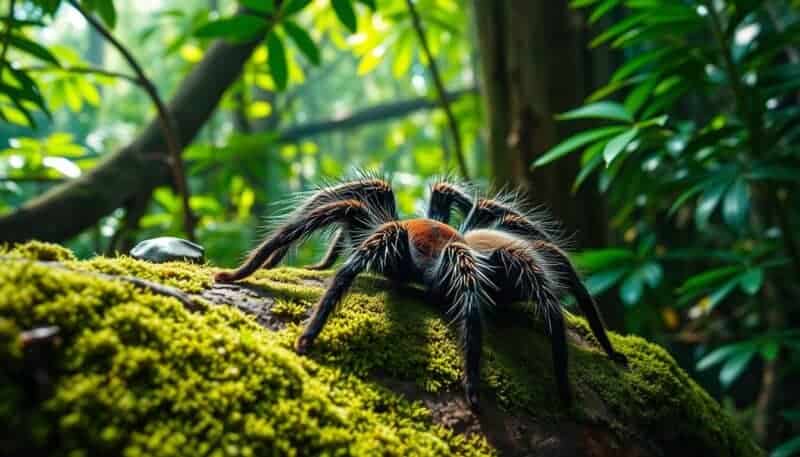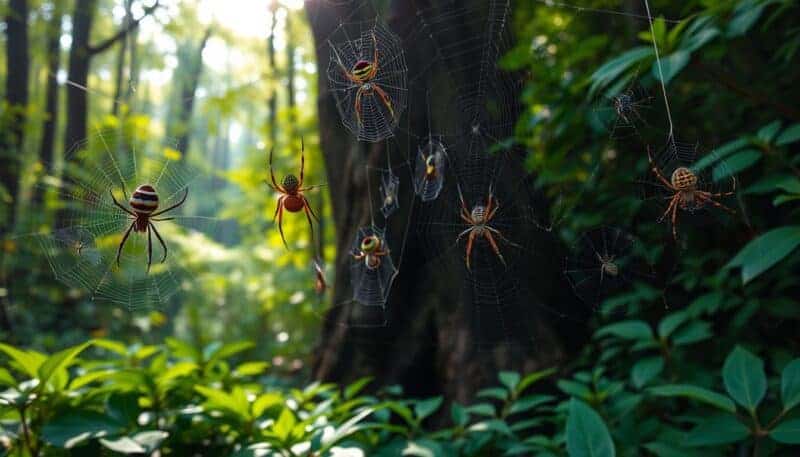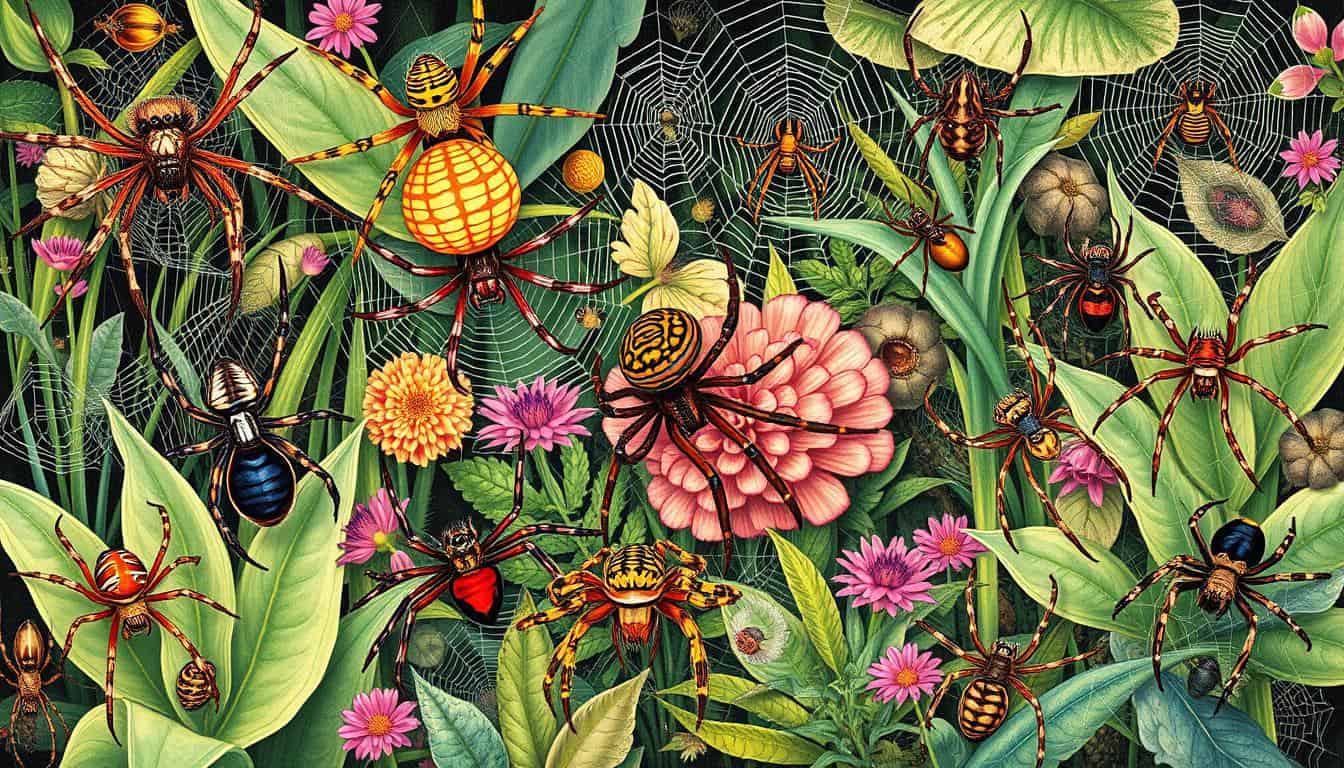Introduction
Did you know there are over 45,000 spider species worldwide? These amazing arachnids vary greatly in shape, size, and behavior. They are among the most diverse animal groups on Earth. This guide explores the fascinating world of spiders, covering their classification, unique traits, and how they adapt to different environments.
From common house spiders to the mysterious tarantulas, you’ll learn about their diversity. This guide helps you identify different spiders, understand their history, and see their importance in ecosystems. Whether you love spiders or just want to know more, this resource will engage and educate you.
- Understanding Spider Classification and Taxonomy
- Common Characteristics of All Spider Species
- True Spiders vs Other Arachnids: Key Differences
- Venomous Spider Species Around the World
- Web-Spinning Spiders and Their Unique Abilities
- Giant Spiders and Tarantula Species
- Most Common Household Spider Species
- Rare and Endangered Spider Species
- Spider Habitat Distribution and Ecosystems
- Spider Behavior and Social Structure
- Conservation Status and Human Impact
- FAQ:
Understanding Spider Classification and Taxonomy
Explore the fascinating world of spider classification and taxonomy with us. Discover the secrets of arachnology as we delve into the different families, major groups, and the evolution of these eight-legged wonders.
Family Classifications in Arachnology
Spiders belong to many families, each with its own traits and ways of living. Some well-known families include:
- Araneidae (Orb-Weaver Spiders)
- Theridiidae (Cobweb Spiders)
- Lycosidae (Wolf Spiders)
- Salticidae (Jumping Spiders)
- Thomisidae (Crab Spiders)
Major Taxonomic Groups
Spiders are divided into several major groups, each with unique features and evolutionary paths:
- Mygalomorphae (Tarantulas and Trap-Door Spiders)
- Araneomorphae (Modern or “True” Spiders)
- Mesothelae (Primitive Spiders)
Evolution and Diversity
Spiders have long fascinated scientists with their evolutionary journey. From the ancient Mesothelae to the modern Araneomorphae, their diversity is truly amazing.
| Spider Family | Distinctive Features | Habitat Preferences |
|---|---|---|
| Araneidae | Orb-shaped web construction, diverse range of body shapes and sizes | Primarily found in forested areas and urban environments |
| Theridiidae | Irregular, tangled web patterns, often found in corners and crevices | Widespread, found in a variety of habitats including homes and gardens |
| Lycosidae | Robust bodies, fast-moving hunters, often seen running on the ground | Diverse, from grasslands and deserts to forests and urban areas |
“The study of spider taxonomy and classification is a captivating journey into the intricate web of arachnid diversity.”
Common Characteristics of All Spider Species
Spiders are fascinating members of the arachnid family. They share many spider characteristics and arachnid features. These traits make them unique in the natural world. Their web-weaving skills and sensory adaptations are just a few things that amaze us.
Spiders have a special body structure. It includes two main parts: the cephalothorax and the abdomen. The cephalothorax holds the spider’s vital organs. The abdomen has the digestive system and reproductive organs.
Spiders also have an advanced sensory system. This includes multiple eyes, sensitive hairs, and special organs. These help them detect prey, navigate, and communicate with others.
- Spiders have great eyesight, with some having up to eight simple eyes. This gives them a wide view of their surroundings.
- Their bodies have sensitive hairs. These hairs can detect even the slightest vibrations. This helps them sense prey or predators.
- Special organs, like the trichobothria, help spiders detect air currents. They also navigate with precision. Their sense of touch is highly developed through chemoreceptors on their legs and pedipalps.
These shared traits, along with their unique hunting, web-building, and reproduction methods, make spiders captivating. They continue to amaze and captivate us.
“Spiders are the master architects of the natural world, weaving intricate tapestries that not only serve as hunting grounds but also showcase their innate artistry.”
True Spiders vs Other Arachnids: Key Differences
Exploring the world of arachnids reveals key differences between true spiders and their relatives. Knowing these differences helps us identify and appreciate these fascinating creatures.
Anatomical Features
True spiders, part of the order Araneae, have unique features. They are composed of two main body parts. – the cephalothorax and the abdomen. Other arachnids, like scorpions and ticks, have only one body part.
Spiders also have eight legs and two chelicerae. These are used for catching prey and moving around.
Behavioral Patterns
- True spiders can spin webs for hunting and building homes.
- They use different hunting strategies, like ambush or active pursuit.
- Other arachnids, like scorpions, rely on venom and strength to catch prey.
Habitat Preferences
True spiders live in many places, from forests to cities. Their ability to adapt to various environments makes them unique.
| Characteristic | True Spiders | Other Arachnids |
|---|---|---|
| Body Segments | Cephalothorax and Abdomen | Single Fused Body Segment |
| Legs | 8 Legs | Varies, but not always 8 legs |
| Chelicerae | 2 Chelicerae | Varies, may have different mouthparts |
| Web Spinning | Yes | No |
| Hunting Strategies | Web-based, Ambush, Active Pursuit | Venom, Physical Strength |
| Habitat Preferences | Diverse, Adaptable | Specific Requirements |
Understanding true spiders’ anatomy, behavior, and habitats deepens our appreciation for them. They stand out from their relatives in many ways.
Venomous Spider Species Around the World
When we talk about the world’s most venomous spiders, the black widow and other dangerous arachnids get a lot of attention. Their powerful venom has made them infamous. It’s important to know about these spiders to stay safe.
The black widow spider, or Latrodectus, is the most well-known venomous spider. They are present all over the world, with Antarctica being the only exception. Their black bodies with red hourglass markings are easy to spot. Their venom can be dangerous if not handled right away.
Other venomous spider species like the funnel-web spider and the Brazilian wandering spider are also feared. They can be deadly. Knowing where they live and how to avoid them is key.
Even though venomous spiders can be scary, they are important in nature. Learning about their habits and how to react to bites helps us live with them safely. This way, we can respect their place in the world.
Web-Spinning Spiders and Their Unique Abilities
In the world of arachnids, web-spinning spiders are truly special. They include famous orb weavers and others. These spiders create complex webs that are both homes and hunting grounds.
From their web designs to the method they use to catch prey, they show us the remarkable abilities of web spinners and their spider silk.
Web Types and Construction
Web-spinning spiders are experts at making different webs. They create everything from orb webs to three-dimensional triangle webs. Building these webs is a skillful process that involves using spider silk carefully.
Hunting Strategies
The way these spiders hunt is fascinating. Many, like orb weavers, wait in their webs for prey. Others, like crab spiders, hunt more actively, either waiting or chasing prey in their webs.
Silk Production Process
At the core of their abilities is their silk production. Spiders have glands that make various types of silk. This silk is strong, elastic, and sticky, used for web foundations and catching prey.
Web-spinning spiders amaze us with their web designs, hunting methods, and silk production. They show us the incredible adaptations and skills of spiders. This inspires awe and appreciation for nature.
Giant Spiders and Tarantula Species
Explore the world of giant tarantulas and other huge arachnids. These large spiders amaze us with their size, detailed webs, and special behaviors. Learn about their different kinds, where they live, how they adapt, and their important role in nature.
The Goliath birdeater, the biggest spider in the world, and the colorful, venomous Poecilotheria genus show the beauty of tarantulas. These amazing giant spiders not only interest us but also play key roles in their homes. They hunt and are hunted, showing the complex balance of life.
Discover how these large arachnids have special venom, quick moves, and skill in making webs. See where they live, from South America’s rainforests to the American Southwest’s deserts. This will help us appreciate the wide variety of spiders.
“Tarantulas are not the gentle, docile creatures that many people imagine. They are fierce predators, capable of taking down prey much larger than themselves.”
As we learn more about giant spiders and tarantulas, we see a fascinating and often misunderstood part of nature. By learning about these amazing arachnids, we can grow to respect and understand the complex web of life we’re all part of.

Most Common Household Spider Species
As you move around your home, you might see different household spiders and indoor arachnids. Knowing the common spider types in our homes is key for good spider control. It helps us live peacefully with them.
Indoor Spider Identification
Common spiders in homes are the Cellar Spider, House Spider, Daddy Longlegs, and Jumping Spider. They differ in size, color, and how they spin webs. Being aware of who they are is the first step to managing them.
Management and Prevention
- Seal cracks and crevices: Close off any openings for spiders around windows, doors, and baseboards.
- Remove clutter: Keep your home tidy and clutter-free, especially in dark spots.
- Use natural repellents: Try essential oils like peppermint or citrus to keep spiders away.
- Maintain a clean environment: Vacuum, dust, and clean often to get rid of spider food like insects and debris.
Beneficial Aspects
Household spiders might seem like pests, but they’re actually helpful. Indoor arachnids eat other pests like flies, mosquitoes, and spiders. By understanding their role, we can live better with them.
“Spiders are an integral part of the ecosystem, helping to maintain a healthy balance by feeding on other insects and arthropods.”
Rare and Endangered Spider Species
In the vast world of arachnids, there are endangered spiders and rare arachnids that need our attention. These creatures face many threats and show how fragile our ecosystems are. They highlight the importance of spider conservation.
The Desertas wolf spider is a rare find on the Desertas Islands off Portugal. It has a population of less than 1,000. Threats like habitat loss and climate change put it at risk.
- The Desertas wolf spider is known for its distinctive markings and exceptional predatory abilities.
- Conservation efforts have focused on protecting the spider’s fragile island habitat and monitoring its population.
- Researchers are working to better understand the biology and ecology of this rare arachnid in order to develop effective conservation strategies.
The Karoo button spider is found in a small area of South Africa. It’s endangered due to habitat loss and urban development. These threats are making its home smaller.
| Spider Species | Conservation Status | Estimated Population | Primary Threats |
|---|---|---|---|
| Desertas wolf spider | Endangered | Fewer than 1,000 individuals | Habitat loss, invasive species, climate change |
| Karoo button spider | Endangered | Unknown, but highly localized | Habitat fragmentation, urban development, agricultural expansion |
These rare and endangered spider species are not just fascinating. They also play key roles in their ecosystems. Saving them is crucial for our planet’s health and biodiversity.

“The fate of these rare arachnids is inextricably linked to the health of our environment. By protecting their habitats and understanding their unique biology, we can ensure the survival of these remarkable creatures for generations to come.”
Spider Habitat Distribution and Ecosystems
Spiders are incredibly adaptable, living in many different places around the world. They can be found in everything from the green canopies of rainforests to the dry deserts. This shows how diverse and strong the spider world is.
Geographic Ranges
Spiders live on every continent except Antarctica. They can be found in many places, like forests, grasslands, wetlands, and even cities. Where spiders live depends on the climate, plants, and food available.
Environmental Adaptations
Spiders have amazing ways to survive in their homes. Some can feel their prey and predators with special senses. Others make special webs to catch food in their environments. These skills help spiders live in many different places and keep their ecosystems balanced.
Spiders’ ability to adapt to many conditions shows their success and importance in the world. They help keep the balance in their ecosystems.
Spider Behavior and Social Structure
Spiders are fascinating creatures that go beyond being insect hunters. They have complex mating rituals, amazing web-building skills, and even social interactions. These behaviors show how smart and social spiders can be.
Spiders have unique mating rituals. Males perform dances to attract females. Some even give gifts to impress them. This shows their advanced social and cognitive skills.
Spiders are also great architects. They build webs that are both beautiful and functional. Some spiders even work together to create huge, complex webs.
Not all spiders live alone. Some live in groups and work together. They have hierarchies, hunt as a team, and even take care of their young. The social spider is a great example of this.
| Spider Behavior | Description |
|---|---|
| Mating Rituals | Elaborate courtship dances, gift-giving to impress mates |
| Web-building | Intricate web designs, coordinated web construction in colonies |
| Social Interaction | Hierarchical structures, cooperative hunting, parental care in some species |
Exploring spider behavior and social structure reveals their amazing adaptations. From their captivating mating rituals to their incredible web-building, spiders are truly fascinating. They enthrall us with their extraordinary abilities.
Conservation Status and Human Impact
Spider species worldwide face threats from human activities. Habitat loss, pesticide use, climate change, and urbanization harm many spiders. These arachnids are vital for ecosystem balance, making their conservation key for environmental health.
Threats to Spider Populations
Habitat destruction is a major threat to spiders. Human development takes over natural areas, leaving spiders without homes. Pesticides and chemicals in agriculture and cities also harm spider communities, disrupting their food webs and reproduction.
Protection Measures
Efforts to protect spiders include creating protected habitats and reducing pesticide use. Sustainable land management and education campaigns also help. These actions promote the understanding of spiders’ role in ecosystems.
FAQ:
How many types of spiders are there?
There are over 50,000 identified members of all spider species, with countless more yet to be discovered. These arachnids span diverse habitats, from deserts to rainforests, showcasing remarkable adaptability. All spider species are classified into families like tarantulas, orb-weavers, and jumping spiders, each contributing uniquely to ecosystems across the globe.
What is the cutest spider called?
Among all spider species, the Peacock Spider is often hailed as the cutest. Native to Australia, this tiny arachnid charms enthusiasts with its vibrant colors and intricate courtship dances. Unlike other members of all spider species, its expressive movements and captivating appearance make it a favorite for arachnid admirers worldwide.
What is the most aggressive spider?
Among all spider species, the Brazilian Wandering Spider is considered the most aggressive. Known for its defensive posturing and potent venom, it reacts quickly to threats. Unlike many of all spider species, this spider actively roams rather than waiting in webs, increasing the likelihood of encounters and solidifying its fierce reputation.
Is there a rare spider?
Among all spider species, the Gooty Sapphire Ornamental Tarantula stands out as exceptionally rare. Found in the forests of India, this spider is renowned for its vibrant blue hues and elusive nature. Conservation efforts are vital to protect such unique members of all spider species, as habitat loss threatens their survival.
How old are spiders?
All spider species exhibit varying lifespans, typically ranging from one to two years. However, certain tarantulas, among the largest of all spider species, can live for decades under optimal conditions. Environmental factors, diet, and predation heavily influence their longevity, highlighting the incredible adaptability and diversity within all spider species.
What is the biggest spider?
Among all spider species, the Goliath Birdeater holds the title of the biggest. Native to South America, this tarantula boasts a leg span of up to 12 inches and can weigh over 6 ounces. Despite its name, it rarely preys on birds, showcasing the incredible diversity found within all spider species.
How do spiders sleep?
Though all spider species lack eyelids, they enter a state of rest resembling sleep. During this period, their metabolic rate slows, and they remain motionless, often hanging from webs or sheltered spaces. While not identical to human sleep, this behavior allows all spider species to conserve energy and recover for hunting.
Share your thoughts in the comments below! If you enjoyed this post, consider subscribing to our newsletter for more pet tips, stories and blogs!

